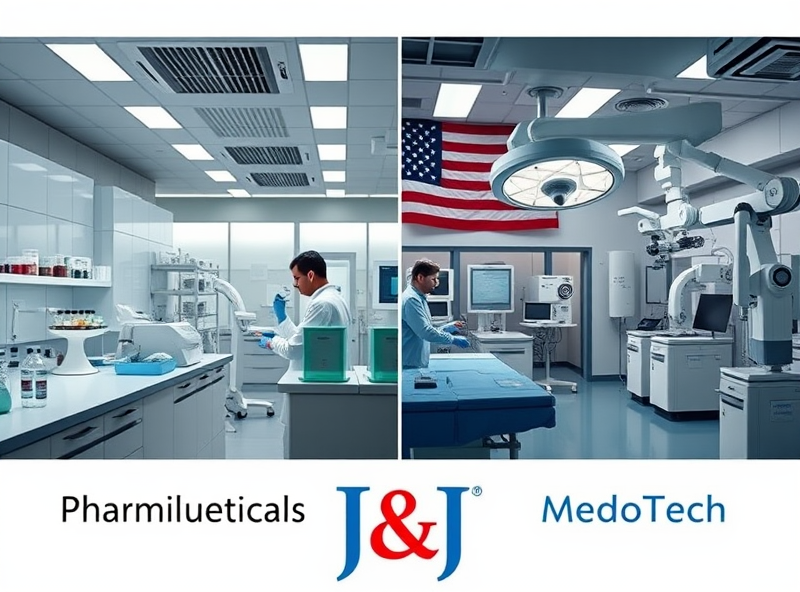
Johnson & Johnson’s Business Structure and Investment Stability
Why J&J Stock Stays Strong: The Power of Its Two Core Segments

Johnson & Johnson (J&J) is one of the world’s most resilient and stable companies, thanks in large part to its diversified business structure. This dual-segment model not only supports consistent revenue generation but also enhances long-term investment stability.
J&J operates through two primary business segments: Pharmaceuticals and MedTech (formerly Medical Devices). Each segment plays a distinct role in the company’s growth strategy and financial performance.
The Pharmaceutical segment is J&J’s largest revenue contributor, focusing on innovative medicines in areas like oncology, immunology, neuroscience, and infectious diseases. With blockbuster drugs such as Stelara and Darzalex, this segment has shown strong growth and robust R&D investment, which helps ensure a pipeline of future therapies.
The MedTech segment, on the other hand, provides a steady stream of income through surgical technologies, orthopedics, and interventional solutions. This segment is less volatile than pharmaceuticals and benefits from consistent demand driven by aging populations and advancements in medical procedures.
This dual structure offers a balanced risk profile. While pharmaceuticals provide high growth potential, MedTech offers defensive stability. For investors, this means that J&J can weather economic downturns better than many single-segment companies. Moreover, the company’s ability to reinvest profits from one segment into the innovation of another creates a self-sustaining growth cycle.
In 2023, J&J completed the spin-off of its consumer health division, Kenvue, to sharpen its focus on these two core segments. This strategic move further solidifies its position as a focused healthcare leader with diversified yet synergistic operations.
For those seeking a stable, long-term investment in the healthcare sector, understanding J&J’s dual-segment structure is key. It not only showcases the company’s resilience but also its strategic foresight in navigating a complex and evolving industry.
Source: https://www.jnj.com/about-jnj/johnson-johnson-announces-2023-first-quarter-results
Diversified Structure: Inside J&J’s Dual Business Segments

Johnson & Johnson (J&J) is widely recognized not only for its consumer health products but also for its robust and diversified business structure. This structure is key to its long-term investment stability and strategic growth in the U.S. market.
J&J operates through two primary business segments: Pharmaceuticals and MedTech (formerly Medical Devices). The company recently completed the spin-off of its Consumer Health division into a separate publicly traded company, Kenvue, allowing J&J to sharpen its focus on high-growth, high-margin sectors.
The Pharmaceutical segment, which includes blockbuster drugs like Stelara and Darzalex, is the company’s largest revenue driver. J&J continues to invest heavily in R&D, allocating over $14 billion annually to develop treatments in oncology, immunology, and neuroscience. This positions the company to remain competitive in the evolving biotech landscape.
Meanwhile, the MedTech division is gaining momentum through strategic acquisitions and innovations in surgical robotics, orthopedics, and cardiovascular solutions. J&J’s acquisition of Abiomed in 2022, a leader in heart pump technology, exemplifies its commitment to long-term growth in life-saving medical technologies.
From an investment perspective, J&J’s diversified structure provides a buffer against volatility in any single market segment. Its consistent dividend payments for over 60 years and AAA credit rating (one of only two U.S. companies with this rating) make it a reliable choice for long-term investors.
For those seeking stability and growth in the healthcare sector, J&J’s dual-segment strategy offers a compelling blend of innovation, resilience, and financial strength.
Source: https://www.jnj.com/about-jnj
Stable Financials and Reliable Dividends That Attract Investors

Johnson & Johnson (J&J) has long been a beacon of financial stability, making it a favorite among long-term investors. With over 130 years of operational history, the company has built a resilient business model supported by its diversified portfolio across pharmaceuticals, medical devices, and consumer health products. This structure not only cushions the company against sector-specific downturns but also ensures consistent revenue streams.
One of the most attractive aspects for investors is J&J’s commitment to reliable dividend payments. As of 2024, J&J has increased its dividend for 61 consecutive years, earning it a place among the elite Dividend Kings. This consistency is a testament to its strong cash flow and disciplined financial management. For income-focused investors, such reliability is a key factor in portfolio planning.
Moreover, J&J maintains a AAA credit rating from S&P Global—one of only two U.S. companies to hold this distinction—highlighting its low credit risk and robust balance sheet. This rating provides investors with confidence in the company’s ability to weather economic fluctuations and continue rewarding shareholders.
For those seeking a dependable investment with long-term growth potential and stable income, Johnson & Johnson remains a top-tier choice.
Source: https://www.spglobal.com/ratings/en/research/articles/230421-u-s-corporate-ratings-history-2023-update-12820358
Risk Management and Market Outlook: Why Analysts Still Say ‘Buy’

Johnson & Johnson (J&J) remains a favorite among long-term investors, and for good reason. Despite global economic uncertainties, analysts continue to rate J&J as a ‘Buy’ due to its strong risk management strategies and stable market outlook. At the heart of J&J’s resilience is its diversified business model, spanning pharmaceuticals, medical devices, and consumer health products. This diversification cushions the company against sector-specific downturns and allows it to maintain steady cash flow even during market volatility.
J&J’s risk management is deeply integrated into its operational and financial planning. The company maintains a conservative debt profile, strong credit ratings (AAA by S&P), and a consistent dividend payout history spanning over 60 years. These factors contribute to investor confidence, especially in uncertain times. Moreover, J&J’s global footprint helps mitigate geopolitical and regional risks, while its commitment to R&D ensures long-term innovation and competitiveness.
Analysts also point to J&J’s ability to adapt to regulatory changes and litigation risks, particularly with its proactive legal settlements and strategic spin-offs like the recent separation of its consumer health division into Kenvue. This move allows J&J to focus more on high-growth segments like pharmaceuticals and medtech, which are expected to drive future earnings.
In summary, J&J’s comprehensive risk management, diversified revenue streams, and forward-looking strategy make it a stable and attractive investment. For investors seeking long-term value with lower volatility, J&J continues to be a strong contender.
Source: https://www.morningstar.com/stocks/xnys/jnj/quote






